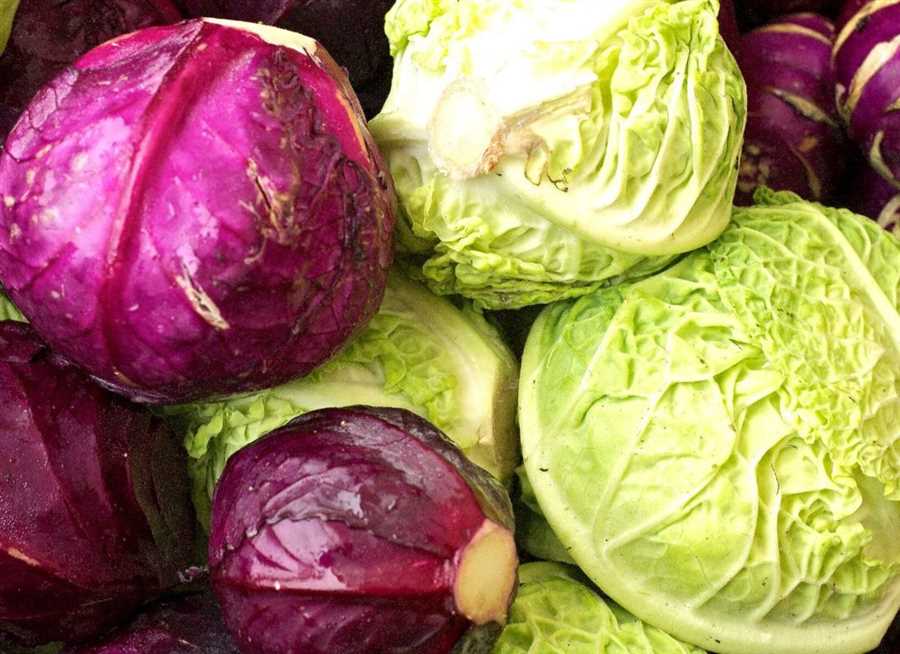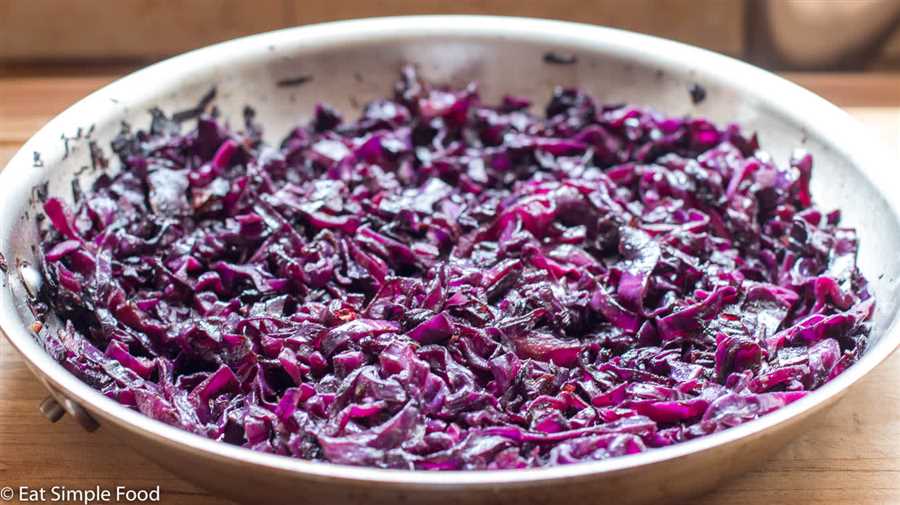Purple cabbage and green cabbage are two different varieties of cabbage that can be used interchangeably in many recipes. They both belong to the Brassica oleracea family and are packed with nutrients. However, their colors and flavors differ, which can affect the overall taste and appearance of a dish.
Green cabbage is the most common variety of cabbage and is known for its pale green color and mild flavor. It is often used in stir-fries, salads, coleslaws, and soups. Green cabbage can be cooked in various ways, including steaming, boiling, sautéing, or braising. Its tender leaves make it easy to work with, and it pairs well with a variety of ingredients.
Purple cabbage, on the other hand, has vibrant purple leaves and a slightly peppery flavor. It adds a pop of color to any dish, making it a popular choice for salads, slaws, and garnishes. While purple cabbage can be cooked using the same methods as green cabbage, it may take slightly longer to cook due to its denser texture.
Whether you’re cooking with purple or green cabbage, both varieties offer a range of health benefits. They are low in calories and high in fiber, vitamins, and minerals. Cabbage is also rich in antioxidants and is known for its anti-inflammatory properties. So, don’t hesitate to experiment with different cabbage varieties in your recipes!
Comparison between purple cabbage and green cabbage
Both purple cabbage and green cabbage belong to the same brassica family and offer a range of health benefits. However, there are some key differences between the two varieties.
Appearance
Purple cabbage, as the name suggests, has a vibrant purple color throughout its leaves. On the other hand, green cabbage has a pale green color, sometimes with a slightly yellow hue.
Taste and Texture

While both types of cabbage have a similar taste, purple cabbage is known to be slightly sweeter than green cabbage. In terms of texture, green cabbage has a more crisp and crunchy feel, whereas purple cabbage is slightly softer.
Nutrition
Both purple cabbage and green cabbage are low in calories and high in nutrients. However, purple cabbage contains a higher amount of antioxidants compared to green cabbage. The vibrant purple color of the cabbage is due to anthocyanins, which are powerful antioxidants that offer numerous health benefits.
Cooking

When it comes to cooking, purple cabbage can be cooked similarly to green cabbage. Both can be used in a variety of dishes, including stir-fries, soups, and salads. However, it’s worth noting that purple cabbage may bleed its color when cooked for a long time, which can affect the appearance of the dish.
In conclusion, purple cabbage and green cabbage have similar taste and texture profiles, but differ in appearance and nutritional content. Both can be cooked in various ways, but purple cabbage may need to be cooked carefully to preserve its vibrant color.
Benefits of cooking purple cabbage
Purple cabbage, also known as red cabbage, is not only visually appealing with its vibrant color but also comes with a variety of health benefits when cooked.
One of the primary benefits of cooking purple cabbage is its high antioxidant content. Purple cabbage contains anthocyanins, a type of antioxidant that gives the cabbage its purple hue. These antioxidants help protect the body against oxidative stress and reduce inflammation.
Cooking purple cabbage also preserves its high vitamin C content. Vitamin C is an essential nutrient that supports a healthy immune system and helps in collagen production, promoting healthy skin and tissue.
Another advantage of cooking purple cabbage is its fiber content. Fiber aids in digestion and helps maintain a healthy gut. It also provides a feeling of fullness, which can be beneficial for weight management.
Cooking purple cabbage is easy and versatile. It can be enjoyed as a side dish, added to salads or soups, or used as an ingredient in various recipes.
To retain its nutritional benefits, it is recommended to cook purple cabbage for a short time using methods such as steaming, stir-frying, or sautéing. Overcooking can lead to loss of nutrients.
In conclusion, cooking purple cabbage not only enhances its flavor and appearance but also provides numerous health benefits. Incorporating this nutrient-rich vegetable into your diet can contribute to overall well-being.
Methods of cooking purple cabbage
If you have purple cabbage on hand and are looking for different ways to prepare it, there are several methods you can try. Here are some ideas:
- Roasting: Roasting purple cabbage is a great way to bring out its natural sweetness. Simply slice the cabbage into wedges, drizzle with olive oil, sprinkle with salt and pepper, and roast in the oven at 400°F (200°C) for about 25-30 minutes, or until tender.
- Steaming: Steaming purple cabbage is a healthy cooking method that helps retain its vibrant color and crunchiness. Cut the cabbage into small pieces, place in a steamer basket, and steam for 5-7 minutes, or until tender-crisp.
- Stir-frying: Stir-frying purple cabbage with other vegetables and protein is a quick and tasty way to cook it. Slice the cabbage thinly, heat some oil in a pan or wok, add the cabbage and any other desired ingredients, and stir-fry for a few minutes until tender.
- Braising: Braising purple cabbage involves cooking it slowly in liquid until it becomes tender and flavorful. Start by sautéing onions and garlic in a large pot, then add the sliced cabbage, some vegetable broth, vinegar, and your choice of spices. Simmer on low heat for about 30-40 minutes, or until the cabbage is soft.
- Pickling: Pickling purple cabbage is a great way to preserve it and add a tangy flavor to your meals. Thinly slice the cabbage and place it in a jar. In a saucepan, combine vinegar, water, sugar, salt, and spices, and bring to a boil. Pour the brine over the cabbage, seal the jar, and let it sit in the refrigerator for at least a week before consuming.
Whether you prefer a roasted, steamed, stir-fried, braised, or pickled version, purple cabbage can be cooked in a variety of ways to suit your taste and dietary preferences. Experiment with these methods and enjoy the unique flavor and beautiful color of this nutritious vegetable.
Recipes using purple cabbage
Purple cabbage, also known as red cabbage, is a versatile and nutritious vegetable that can be used in a variety of recipes. Its vibrant color adds visual appeal to any dish, making it an excellent choice for both cooking and garnishing. Here are some delicious recipes that feature purple cabbage:
- Purple Cabbage Slaw: This refreshing slaw is made with shredded purple cabbage, carrots, and a tangy dressing. It’s a perfect side dish for barbecues and picnics.
- Purple Cabbage Stir-Fry: Sautéed purple cabbage with garlic, ginger, and soy sauce creates a flavorful and colorful stir-fry. Serve it with quinoa or rice for a complete meal.
- Purple Cabbage Rolls: Stuff large purple cabbage leaves with a mixture of cooked quinoa, vegetables, and spices. Bake them in tomato sauce for a healthy and delicious vegetarian dish.
- Purple Cabbage Salad: Combine thinly sliced purple cabbage with arugula, apples, and walnuts for a refreshing and crunchy salad. Drizzle it with a lemon vinaigrette for a burst of flavor.
- Purple Cabbage Soup: Make a comforting soup by simmering purple cabbage with onions, carrots, and vegetable broth. Add your favorite herbs and spices to customize the flavor.
These are just a few ideas for incorporating purple cabbage into your cooking. Its mild flavor and crunchy texture make it a great addition to many dishes. Be creative and experiment with different recipes to enjoy the unique taste and vibrant color of purple cabbage.
Questions and answers
Can you use purple cabbage in the same way as green cabbage?
Yes, you can use purple cabbage in the same way as green cabbage. It can be cooked, steamed, sautéed, or used raw in salads or slaws. The only difference is that purple cabbage tends to have a slightly stronger flavor and may dye other ingredients or liquids purple when cooked.
What are some ways to cook purple cabbage?
There are several ways to cook purple cabbage. You can sauté it with some olive oil and garlic, steam it until tender, or braise it with onions and vinegar. Purple cabbage can also be used in stir-fries, soups, or roasted in the oven. It can even be pickled for a tangy and colorful side dish.
How do you prepare purple cabbage for cooking?
To prepare purple cabbage for cooking, start by removing any wilted outer leaves and rinsing it under cold water. Next, cut the cabbage in half and remove the core. From there, you can slice, dice, or shred the cabbage, depending on your recipe. Make sure to also separate the leaves if you plan on using them for stuffing or wrapping other ingredients.
What color does purple cabbage turn when cooked?
Purple cabbage will generally turn a blue-ish or purple color when cooked. The vibrant purple color of raw purple cabbage can fade during cooking, but it can still add a pop of color to your dish. Keep in mind that adding acidic ingredients, like vinegar or lemon juice, to your cooking liquid can help preserve the purple color.
Can you substitute green cabbage for purple cabbage in recipes?
Yes, you can usually substitute green cabbage for purple cabbage in recipes. However, keep in mind that green cabbage has a milder flavor compared to purple cabbage. So if you use green cabbage instead, your dish may be slightly less flavorful. Additionally, the color will obviously be different, but it shouldn’t impact the overall taste or texture of the dish.
Can I use purple cabbage instead of green cabbage in a recipe?
Yes, you can use purple cabbage instead of green cabbage in a recipe. However, keep in mind that purple cabbage may have a slightly different taste and texture compared to green cabbage.
How do I cook purple cabbage?
To cook purple cabbage, start by removing the outer leaves and slicing it into thin strips. Then, heat some oil in a pan and sauté the cabbage for a few minutes until it starts to soften. You can also braise, steam, or roast purple cabbage for different recipes. Experiment with different cooking methods to find your favorite.






